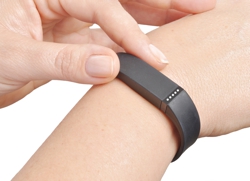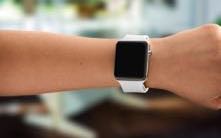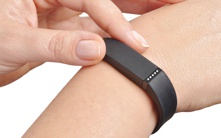![]() These days the world seems to be very conscious of health and fitness with activity trackers being a very common addition to most people’s must-have day-to-day items. It’s hard to ignore going to the gym when you have a little device that tells you you’ve only done 2,000 steps that day when you should have done 10,000! Popular fitness trackers include Fitbit, Jawbone, Garmin, TomTom, and the Apple Watch to just name some.
These days the world seems to be very conscious of health and fitness with activity trackers being a very common addition to most people’s must-have day-to-day items. It’s hard to ignore going to the gym when you have a little device that tells you you’ve only done 2,000 steps that day when you should have done 10,000! Popular fitness trackers include Fitbit, Jawbone, Garmin, TomTom, and the Apple Watch to just name some.
See Also: Fitbit | Smart Watches | Apple Watch | Protein
Shops With Fitness Tracker Offers
Categories
Fitness Tracker Buying Guide
![]()
The developments in technology are useful for a whole host of reasons; whether it’s using a sat-nav to find to your way from one part of the country to another or you simply want to send an email from the toilet, the smaller the technology gets the more uses companies are finding for it.
And so we begin our Buyer’s Guide to Fitness Trackers, the small bands that typically tend to fit on your wrist and can tell you how active you’ve been over a given amount of time. It doesn’t matter whether you’re a fitness freak that just wants to confirm how much you’ve been working out, or someone that has never even moved off the couch in the past that wants to use it as an inspiration for yourself moving forward, picking a decent fitness tracker could make all the difference.
There are a whole host of fitness trackers available on the market that all offer different features. On the one hand this means that there will definitely be a tracker than can cater to your needs, yet on the other hand it means that the market can be somewhat over-whelming. For the sake of clarity, we’ll only be looking at devices that have the specific job of monitoring or tracking your fitness. Smart Watches also offer that feature, but as it is not their primary function we’re not going to discuss them here.
How Do They Work & What’s the Point?
![]() Let’s start with one of the most basic things of all: How the trackers actually work. Obviously each one is different and the technology they employ differs depending on what features the tracker offers. In general, though, they’ll use an array of sensors within the device that can monitor and track your movements. Pretty much all fitness bands use an accelerometer to track your steps, whether that be up and down, back to front or from side to side. Some can even tell if you’ve claimed a flight of stairs by using a barometer.
Let’s start with one of the most basic things of all: How the trackers actually work. Obviously each one is different and the technology they employ differs depending on what features the tracker offers. In general, though, they’ll use an array of sensors within the device that can monitor and track your movements. Pretty much all fitness bands use an accelerometer to track your steps, whether that be up and down, back to front or from side to side. Some can even tell if you’ve claimed a flight of stairs by using a barometer.
Other sensors that can sometimes be found in a tracker include a heart-rate monitor, used to track the changes in your pulse throughout the day. That can be a particularly useful function if you’re the sort of person that likes to enjoy cardiovascular work-outs. A gyroscope can also be found in some fitness bands, so it will know whether you’re standing, sitting down, lying back, swimming or cycling, for example.
Not all fitness bands feature a GPS, so if you’re keen on a fitness tracker that can monitor your location in order to give you specific feedback about where you’ve been and how far you’ve travelled do bear that in mind. Similarly some bands will have a magnetometer, a sensor that tracks your orientation to the Earth’s magnetic field. Sufficed to say, this sensor allows for much more specific monitoring of your movements and directional changes.
Maybe you’ve already got a heart-rate monitor and aren’t too bothered about buying a fitness band with one built in. That’s fine as some trackers will be able to sync with your external monitor. Some won’t, though, so make sure you find out whether the one you’re considering purchasing will be able to or not before you make your purchase. Similarly some trackers can link up to smart scales, meaning you’ll be able to give more specific measurements to the device’s software.
The in-built features of each given fitness tracker allows you to discover relevant personal information that you might not otherwise know. Having a keen understanding of your own personal goals is key to picking the tracker that is right for you. Not all fitness bands offer sleep monitoring, for example. Have you been told getting regular exercise might help you to sleep better? Make sure the band you choose has this function and you’ll be able to find out for sure if there’s any truth in that assertion.
It’s also worth thinking carefully about what type of activity you’re likely to spend most of your time doing and what things you really enjoy. If you know that you’re a big swimmer there is little point buying a fitness tracker that isn’t waterproof. Equally if you spend most of your time cycling everywhere then making sure your new band can track how long you spend on your bike and how much exercise you do getting from A to B is vital.
Hey Good Looking
Another consideration you’ll need to take into account regards the design of the fitness tracker you’re looking at picking up. Do you want a fitness band that will go around your wrist, or would you rather have an unobtrusive one that clips to your belt and allows you to forget all about it? Alternatively, would you like one that gives you the option to do both depending on what you’re up to?
Those are questions you should consider when you’re narrowing down your fitness band options. If you’re the sort of person that likes to see how many steps you’ve done, or how close you are to your daily target, then you’ll need a tracker that you can access easily. You’ll also need one that has got a screen so that you can get the relevant information easily. Some trackers, for example, light up a given amount of LEDs that light up depending on how much exercise you’ve done during the day. Others will allow you to cycle through various bits of information, such as how many steps you’ve taken, how many calories you’ve burned off, how many staircases you’ve climbed and how far you’ve travelled simply by pressing a button on the device.
If you’re going to opt for the type of tracker that sits on your wrist are you hoping that it will replace your watch over time? If so you’ll want to firstly make sure that it will tell you the time and secondly make sure it isn’t horrendously ugly to look at. It will also be worth considering the battery the device contains. If you’re using it as a watch then you really don’t want a device that dies after little more than a day or so of use, do you?
Thankfully fitness band manufacturers have realised that they need to be style conscious if they’re going to break into the mass market. That means that you’ll often be able to pick up a fitness tracker that gives you an array of options on things like band type and colour.
Type of Tracker
Even if you know what style of fitness tracker you want, what features you’d like it to have and roughly how much you’re hoping to spend, you can still narrow your options down further. Something else you should consider is what type of tracker you’d like.
In essence the type of fitness tracker you’re likely to consider will depend on how much of a fitness freak you are. As we mentioned at the start of the article, there are plenty of options on fitness trackers for either those hoping to move from being a couch potato to a regular runner, through to people looking at monitoring their fitness work as they move towards qualifying for the Olympics.
All Day
All-day trackers are the type you should be looking at if you’ve not really considered yourself to be a regular exerciser in the past. These are the ones that will monitor the amount of steps you’ve taken in a day, how many staircases you’ve climbed up (or the equivalent if you tend to live in a hilly area), how long your exercise lasted for, how many calories you’ve burned, how active you’ve been in a day and how much you’ve slept during the night.
Training
Training, trackers, on the other hand, offer much more targeted monitoring of your fitness work. They are the ones that often have built-in heart-rate monitors, can track your breathing patterns, they can tell you how much distance you’ve covered, what your speed was and whether your altitude changed significantly, they’ll allow you to control your music and also monitor the route you went on if you excised outdoors.
As you might expect, the devices that offer the more targeted monitoring also tend to be slightly more expensive. It’s not guaranteed, of course, but they also tend to be more accurate, too. All-day trackers are brilliant at giving you a general idea of how much exercise you’ve done and how well you’ve used your time, but the ones that offer specific target monitoring will naturally be clearer with their feedback.
We’ve mentioned this several times already, but the importance of knowing what you want to use your tracker for cannot be over-stated. There really are so many fitness trackers on the market that there will almost certainly be one that can offer you what you’re looking for. Did you know, for example, that there is a tracker specifically designed to analyse your golf swing? The tracker attaches to the end of your club and then uses sensors to monitor your swing, giving you real time information on your swing path and so on. Its companion mobile app can then show you your full swing in 3D, even comparing it to pro-golfers or your own previously recorded efforts.
There is also a monitor that is designed specifically for serious runners. Runsense, by Epson, reportedly takes 35 different measurements in order to monitor things like your heart-rate, distance covered, the pace you’re running at, how many laps you’ve done, what your intervals are like, how fast you’re going and so on. If you’re serious about running then that is the monitor you’ll want to pick up in order to keep an eye on your improvements.
Compatibility
![]() The last, yet arguably most crucial, question you’ll need to ask yourself before you hit the shops is this, ‘Is the fitness band compatible with my existing technology?’ You may not think that having a fitness tracker that interacts with your phone is all that important, but plenty of the fitness bands on the market don’t have an interactive display. With that in mind, you’ll need to link it up to your phone or computer in order to make sense of the fitness work you’ve been doing.
The last, yet arguably most crucial, question you’ll need to ask yourself before you hit the shops is this, ‘Is the fitness band compatible with my existing technology?’ You may not think that having a fitness tracker that interacts with your phone is all that important, but plenty of the fitness bands on the market don’t have an interactive display. With that in mind, you’ll need to link it up to your phone or computer in order to make sense of the fitness work you’ve been doing.
Thankfully for the majority of the population most fitness trackers can sync with both iOS and Android devices. There is a bit of a lag as far as support for Windows phones is concerned, though, so if you’re one of the few people still desperately hoping that a Microsoft driven mobile will become the hip and happening device to own then do be aware of compatibility issues when you go shopping.
Of course there is a way around this, which is to look for a fitness tracker that has a display and gives you the information you need right on the device itself. The only issue is that you might not get the most in-depth analysis from the tracker alone. Some of the FitBit models, for example, can tell you how many steps you’ve taken and how many calories you’ve burned off in the day on the front of the tracker. But if you hook it up to a phone or a computer you can also tell it things like what type of exercise you’ve done and, in return, it can tell you more detailed information about your fitness.
Pretty much all of the fitness trackers on the market also come with a companion app. That’s what you’ll use to discover the more in-depth information that you’re after. Yet you should also consider third party apps that might just offer you a little more functionality than the standard app alone. Myfitnesspal, for example, allows you to enter in the food you’ve eaten during the day. It has a fairly extensive database and can add the calories to such a specific point that it’ll know how much weight you could put on from being told how many Malteasers you’ve eaten.
Some fitness trackers have apps that allow you to change the type of exercise you performed after its has already logged it. That means that if you’re the sort of person who enjoys doing several different types of exercise you can do them without worrying about whether or not your fitness tracker has figured out whether you’re running or swimming.
The point of tracking your fitness so precisely, of course, is that it will let you know how much you’re improving. Let’s say that you’ve never been on a run before in your life but have decided to begin one of the ‘Couch To 5K’ projects that are all over the place at the moment. Wouldn’t it be great to be able to monitor your progress not only week by week by also day by day or even hour by hour? Or if you’re trying to lose weight, being able to compare how many calories you’ve burned off with how many you’ve taken in will help you to know whether you’re heading in the right direction.
Jawbone Activity Trackers
 Jawbone is an American company with headquarters located in San Francisco, California. Next to Fitbit, Jawbone is one of the most popular brands when it comes to activity trackers and probably one of the best options if you want a tracker that’s both user-friendly and fashionable, as many of the wristbands look more like bracelets than mundane fitness trackers. The company makes three different wearable trackers called the Up Move, Up2, and Up3. Below we briefly discuss the various different models, so you can get an idea of which one might be right for you.
Jawbone is an American company with headquarters located in San Francisco, California. Next to Fitbit, Jawbone is one of the most popular brands when it comes to activity trackers and probably one of the best options if you want a tracker that’s both user-friendly and fashionable, as many of the wristbands look more like bracelets than mundane fitness trackers. The company makes three different wearable trackers called the Up Move, Up2, and Up3. Below we briefly discuss the various different models, so you can get an idea of which one might be right for you.
Up Move
The Up Move is comparable to Fitbit’s Zip, which is a basic activity tracker connected to a clip. It comes in a range of stylish colours, including yellow/grey, purple, red, blue/grey, and black. The clip can be discretely clipped to trousers, undergarments, your pocket, etc. The Up Move is the smallest of Jawbone’s three models and covers the basic necessities like steps taken, calories burned, and sleep tracking. You can also log food eaten and set goals for yourself within the Jawbone app. The battery life lasts up to 6 months.
Up 2
The Up 2 is the next model up and is disguised to look more like a fashionable bracelet than anything else. It comes in a range of colours, including: black, grey, purple, tan/gold, fuchsia, and teal, as well as two different style options for the band. It has all the same great features that you’ll find on the Up Move with three additional aspects, including: Smart Alarm, Idle Alert, and Automatic Sleep Detection. The Idle Alert is especially great if you need that extra push to get you moving in the day, as the band will buzz when you haven’t moved for a period of time. The battery life on the Up 2 lasts up to 10 days.
Up 3
Lastly, Jawbone presents the Up 3, which includes the most amount of different features all packaged into a trendy wristband. The band comes in multiple colours like tan/gold, forest green, midnight blue, black, red, and grey. The added features, in addition to all the others we’ve mentioned above in the Up Move and the Up 2 are Advanced Sleep Tracking and Heart Health Monitoring. The downside, however, is the battery life only lasts up to 7 days.
Fitbit Activity Trackers
 Fibit is another American company with headquarters located in California’s healthy & fit San Francisco. Fitbit has a wide range of activity trackers, which they categorise into three different groups: Everyday Fitness, Active Fitness, and Performance Fitness. Below we look at the products within each category, which all come in an ever-changing rainbow of colour options to suit your style.
Fibit is another American company with headquarters located in California’s healthy & fit San Francisco. Fitbit has a wide range of activity trackers, which they categorise into three different groups: Everyday Fitness, Active Fitness, and Performance Fitness. Below we look at the products within each category, which all come in an ever-changing rainbow of colour options to suit your style.
Everyday Fitness
For those looking for an everyday fitness tracker, Fitbit’s offers a range of trackers including: Zip, One, Flex, and Charge. The Zip is your basic model, which like Jawbone’s Up Move, is connected to a clip and tracks the basics like steps taken and calories burned. You can similarly log the food you’ve eaten and set personal fitness goals within the Fitbit app, which syncs with your tracker. The Zip, unlike the Up Move, however, does not do sleep tracking. The next model, however, One, does all the things that the Zip does with the addition of sleep tracking and is similarly attached to a clip, which can be easily hidden on your person.
Other options for those looking for an everyday activity tracker include wristbands: the Flex and the Charge. The Flex, however, does not include a display and you cannot actually see how many steps you’ve taken unless you log onto the app on your phone. There are LED lights on the band, however, that light up as you reach your daily goals, as well as make a small buzz to let you know your progress.
Lastly, we take a look at the Charge, which is also a wristband that comes in a wide range of colours, is a watch, displaying the time, and can even show you who is calling you on your phone. You can also monitor your sleep quality, set alarms, as well as all of the other features mentioned in the models above.
Active Fitness
For those who are a bit more active in their daily life, Fitbit presents the Charge HR, which does all of the above with the addition of heart rate monitoring. The band comes in a stylish bracelet, shows the time, and also notifies you when someone is calling your phone.
Performance Fitness
For all the hardcore fitness fanatics and professionals, the Fitbit Surge does it all. In addition to all of the features we’ve discussed in the other models, the Surge also gives you text notifications, can control your music, and is a GPS tracker. Surge also lets you track every aspect of your training from cycling to running to all things cardio, giving you detailed reports of your workouts to help you see how you’ve improved.
For further information on Fitbit, check out our Fitbit Buying Guide.
Which One to Choose?
 With the myriad of fitness tracker options that are on the market it’s going to be very difficult for you to find one that doesn’t answer your needs. If you want a quick summary to bear in mind when you’re shopping, though, here it is: What exercise are you going to do? What do you want your tracker to monitor? Are you bothered about style or design? Will your tracker work with your current tech?
With the myriad of fitness tracker options that are on the market it’s going to be very difficult for you to find one that doesn’t answer your needs. If you want a quick summary to bear in mind when you’re shopping, though, here it is: What exercise are you going to do? What do you want your tracker to monitor? Are you bothered about style or design? Will your tracker work with your current tech?
Ask and answer those questions, compare what you’re after with what the device on sale is capable of doing and make sure your needs and their abilities match up and you’ll be the proud owner of a brilliantly useful new fitness tracker in no time at all.









